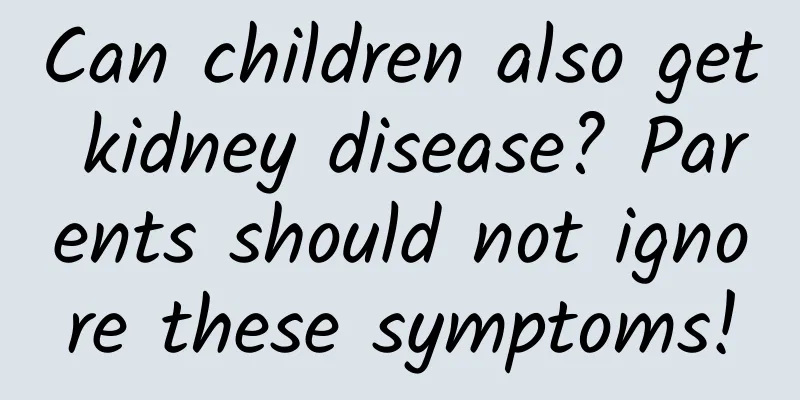Can children also get kidney disease? Parents should not ignore these symptoms!

|
In most people's minds, kidney disease seems to be a "patent" of adults, but the reality is not so. Children can also suffer from kidney disease, and because children cannot accurately express their discomfort, and some early symptoms of kidney disease are not obvious, they are easily ignored by parents, thus delaying treatment. It is very important for parents to understand the common types and symptoms of kidney disease in children, which can not only help children get timely treatment, but also minimize the impact of kidney disease on children's health. There are various types of kidney disease in children, among which the more common ones are acute glomerulonephritis, nephrotic syndrome, purpuric nephritis, etc. Acute glomerulonephritis mostly occurs in children and adolescents, often 1-3 weeks after streptococcal infection such as upper respiratory tract infection and skin infection. The disease has an acute onset, and the main symptoms include hematuria, proteinuria, edema and hypertension. Hematuria is one of the most intuitive symptoms, manifested as red urine, just like meat washing water, sometimes it is not detectable by the naked eye and needs to be detected through routine urine examination; proteinuria refers to the increase in protein content in urine. In severe cases, foamy urine may appear, and these bubbles are fine and difficult to dissipate for a long time; edema usually appears first on the eyelids, especially in the morning, and then gradually spreads to the whole body; hypertension is also common in some children, and children may experience headaches, dizziness, palpitations and other discomfort symptoms. Nephrotic syndrome is also a common kidney disease in children. It is a clinical syndrome caused by a variety of reasons, which increases the permeability of the glomerular basement membrane and causes a large amount of plasma protein to be lost in the urine. The main manifestations are massive proteinuria, hypoproteinemia, severe edema and hyperlipidemia. Massive proteinuria is a hallmark symptom of nephrotic syndrome. A large amount of foam will appear in the child's urine and will not disappear for a long time. This is because a large amount of protein leaks out of the urine. Hypoproteinemia is caused by excessive protein loss, which leads to a decrease in the protein content in the blood. The child may have symptoms such as pale complexion, fatigue, and mental depression. Severe edema can be manifested as pitting edema all over the body, shiny skin, and in severe cases, pleural effusion and ascites may occur, affecting respiratory and digestive functions. Hyperlipidemia is caused by an increase in the compensatory synthesis of lipoproteins by the liver, while the catabolism of lipoproteins is reduced, resulting in an increase in blood lipids in the blood. Purpura nephritis is kidney damage caused by Henoch-Schonlein purpura, which usually occurs within 1-8 weeks after the appearance of skin purpura. In addition to the manifestations of skin purpura, symptoms of kidney involvement will also appear. Skin purpura is more common in the lower limbs and buttocks, with symmetrical distribution and varying sizes. It can merge into pieces and does not fade when pressed. When the kidneys are involved, symptoms such as hematuria, proteinuria, and edema may occur, which are similar to the manifestations of acute glomerulonephritis, but the hematuria of purpura nephritis lasts longer and is prone to recurrence. Children are often not accurate in expressing their physical discomfort, which requires parents to be extra careful and pay attention to the subtle changes in their children's daily lives. If your child has the following symptoms, parents must not take it lightly: 1. Abnormal urine : As mentioned above, hematuria and foamy urine are one of the most common symptoms of kidney disease. Once you find that your child's urine color is abnormal or the foam increases, you should take your child to the hospital for a routine urine test in time. 2. Edema : If a child has unexplained edema in the eyelids, lower limbs, or the whole body, especially obvious eyelid edema in the morning that does not subside after rest, be alert to the possibility of kidney disease. 3. Changes in urine volume : A significant increase or decrease in urine volume may be a sign of kidney problems. If a child's urine volume suddenly increases, accompanied by symptoms such as thirst and polydipsia, there may be a problem with the kidney's concentration function; a decrease in urine volume may indicate impaired kidney excretion function. 4. Poor mental state : Children become less interested in playing, listless, have a poor appetite, and are weak, which may be caused by physical discomfort, among which kidney disease may be one of the reasons. Because kidney disease can cause toxins and waste to accumulate in the body, affecting the child's physical function and mental state. 5. Increased blood pressure : Some children with kidney disease will experience increased blood pressure. If the child complains of symptoms such as headache, dizziness, and palpitations, parents should measure the child's blood pressure in time. If abnormal, further examination is required. Children can also be troubled by kidney disease. As parents, we should always pay attention to the physical health of children and understand the common symptoms of kidney disease in children. Once the child shows abnormal behavior, the child should be taken to the hospital for treatment and relevant examinations in time for early diagnosis and early treatment. Early intervention and treatment are crucial to the prognosis of kidney disease in children. They can minimize the impact of kidney disease on the growth and development of children and physical health, allowing children to grow up healthily and happily. |
<<: Kidney health crisis in the elderly: How to protect kidneys scientifically?
Recommend
Picture of vaginal discharge caused by fungal vaginitis
Candidal vaginitis belongs to Trichomonas vaginit...
Can vulvar leukoplakia be cured? Experts will tell you
Once a woman suffers from vulvar leukoplakia, she...
Perfect head-to-shoulder ratio for women
When it comes to the topic of behavior, one perso...
How is acute leukemia usually diagnosed? Can it be cured?
Author: Jiang Bin, Chief Physician, Peking Univer...
Cystic ovary high testosterone
I believe that everyone is not very familiar with...
How to get through the discomfort of early pregnancy
There is no way to determine the timing of pregna...
The dangers of drinking during menstruation
Wine is a common drink in our lives, and it often...
Sleeping during pregnancy and waking up suddenly
During pregnancy, pregnant women may be affected ...
What should I pay attention to during cervical smear examination?
Gynecological diseases are very important to the ...
Papilloma symptoms of the nipple
When treating a disease, you must first understan...
Misunderstood "emotional intelligence": judging emotions through micro-expressions is indeed a science
Leviathan Press: "A wise man is honest and r...
Why do I have hip pain during my period?
Buttock pain in women during menstruation is a no...
Overview of Breast Pain
Breasts are an important part of every woman'...
What are the precautions for primiparas after spotting?
In the later stages of pregnancy, mothers must pa...









